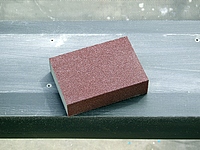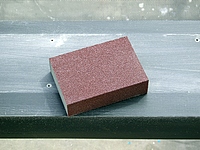Interior surfaces should be perfectly smooth before painting. To accomplish this you may need to use a combination of interior sanding and filling. Techniques for filling are covered under drywall repair.
General Interior Sanding Tips
- Remove hard edges around chips and repairs, and gradually feather to a smooth surface.
- Treat shiny painted surfaces with sandpaper to roughen up the surface a bit. This gives the new finish something to stick to.
- Smooth large, flat areas with a disc or random orbital sander, and follow up by hand sanding. Always work in the direction of the grain if you are working with wood.
- Always keep the sanding pad slightly turned so it does not travel in a straight alignment. This prevents the formation of lines from the edge of the sandpaper.
- Wipe surfaces with a cloth because a clean surface will produce a smoother finish.
- Don’t forget to vacuum all dust and debris when finished sanding.
Wood Sanding Tips
 On painted wood trim, a smooth finish requires more effort. Remove heavy brush strokes or multiple layers of paint with 60 to 80 grit sandpaper, or a medium-to-fine abrasive sponge. Remove sanding marks and smooth the surface with 120 grit paper, or the fine side of a sponge.
On painted wood trim, a smooth finish requires more effort. Remove heavy brush strokes or multiple layers of paint with 60 to 80 grit sandpaper, or a medium-to-fine abrasive sponge. Remove sanding marks and smooth the surface with 120 grit paper, or the fine side of a sponge.
On new wood, smooth with 120 grit paper and finish with either 150 grit or fine sponges. Pay special attention to smoothing out raised grain. Completely remove any shiny areas on the wood’s surface. These patches are referred to as mill glaze. The glaze is produced during shaping. It prevent stains from being absorbed evenly. And it inhibits the adhesion of primer.
Drywall Sanding Tips
- One option for smoothing minor drywall patches is wet sanding. Wet sponges or rags are good materials for this.
- On new drywall, use a large hand drywall sander that can float across the seams to avoid gouges and dips along the drywall joints.
- A newer product, called sanding mesh, is especially suitable for sanding drywall and plaster. Sanding mesh is tough and long-lasting. The mesh allows the dust from the plaster to fall through, allowing it to be reused. It can be used wet or dry and is inexpensive.


